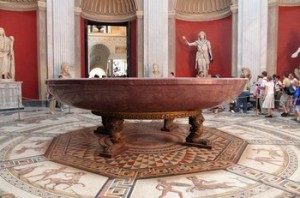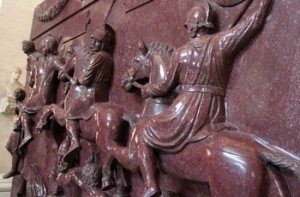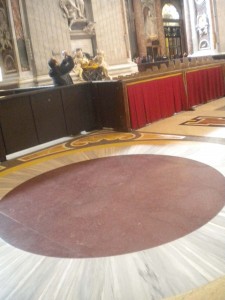Porphyry pavers in various sizes are used now to improve the surfaces of all hardscape projects. Once, there was a more decorative use for porphyry in the interior. Rome and especially the Vatican are filled with imperial porphyry. The museums, churches, and chapels of Vatican City have more imperial porphyry as sculpture and decoration than anywhere else. The Imperial Porphyry found here came from a single mine in Egypt, the Mons Porphyrites. It was imported by the Romans as a decorative accent stone, for use in tiled floors, as colored columns, or occasionally carved into a vase or sculpture. Its color invokes Royal Purple.

Porphyry is extremely hard, also dense and heavy. Even lifting a substantial hunk of porphyry is a great feat, let alone transporting it by ship from Egypt. It is also so hard that it takes very strong, well-tempered steel to cut it, and even then, achieving any great degree of precision is very challenging. The Romans had steel good enough, but this technology was lost in the Middle Ages, making Roman porphyry artifacts not only symbols of the Caesars but of the impossible godlike skills of the ancients, which their weak successors could only marvel at. It was physical, recognizable proof that the Romans could do the impossible. In addition, the location of the mine in Egypt was lost around the fourth century AD, and not successfully rediscovered until 1823.

In the Middle Ages, then, porphyry meant Rome, specifically the lost power of the Caesars who could reach across oceans and achieve impossible feats. Anywhere porphyry appeared it was a Roman relic, and anyone who had it could claim some part of Imperial Rome.
Everyone wanted porphyry, and if you wanted it, you had to steal it. Imperial porphyry value is high in that the stone only exists in Europe in things the Romans built. Therefore, every prince and republic and sculptor who wanted this symbol of Roman power had to steal it from the source. Want to put in a nice porphyry floor for a Church? Loot it from a Roman temple. Want to advertise the imperial majesty of Mary Queen of Heaven? Make the altar out of an old, reworked porphyry sarcophagus. If a pope wanted porphyry columns for his tomb, he had no better source than to go to some surviving Roman temple (say, the Pantheon…) and rip out the porphyry, perhaps substituting some less valuable stone to keep it from falling down.

Some places already had porphyry brought there by the Romans, and in these cases, it was proudly displayed as proof of the noble Roman origins of a town or province. Naturally, the greatest concentration of porphyry lay in and around Rome itself. The farther you are from Rome, the scarcer porphyry becomes. Florence had a couple of columns and the odd basin, but for more porphyry stone, they had to buy or steal from Rome, or elsewhere. The Venetians carried off large pieces of porphyry from Constantinople when they looted it and still display them proudly as pulpits on either side of the main altar in San Marco. Even as far as France, when Louis was decorating Versailles, porphyry was scarce indeed, but what few busts and vases he got hold of went straight into the best places: the throne room, and the Hall of Mirrors. Today, porphyry artifacts still lie in the Vatican, but we use porphyry to grace the outdoor walkways, streets, and paths of our world.
Porphyry formation and composition determine its high compression strength, resistance to stains, slip resistance, and high freeze/thaw ratings. The stone is the most popular paver in Europe and is favored for its flexibility in design, beauty, durability, and low maintenance requirements. ADA Compliant Porphyry pavers are also adaptable to a permeable paving set. The stone is by far one of the most durable pavers in the world. These beautiful materials are available from Milestone Imports. Milestone supports the creativity of architects, planners, and designers. Porphyry color and finishes vary, but tend towards tones of grey, gold, violet, and red, depending on where it is extracted. The products are available in North America from Milestone Imports.
Let’s chat! Learn more about Milestone Imports today.



